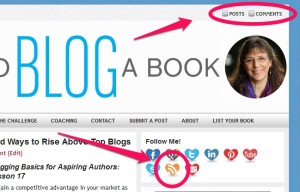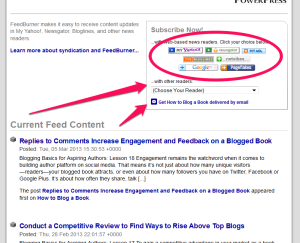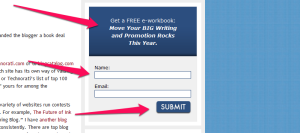 Blogging Basics for Aspiring Authors: Lesson 19
Blogging Basics for Aspiring Authors: Lesson 19
When your blogged book (or blog) begins to attract readers, you don’t want them to just read one post and go away…possibly never to come back. You want to provide a way for them to opt into staying in touch with you and your blog—so you can stay in touch with them. This allows you to contact your readers for all sorts of reasons, including notifying them when your blogged book is released in ebook or printed book form. Of course, there are lots of other important reasons to contact readers as well, such as to offer them more great information and to tell them about your products and services. Generally, though, you want to make it easy for your readers to get your blog posts (and read your blogged book as you write it) and for you to contact your readers.
The two most common ways to contact readers are with:
- Really Simple Syndication (RSS) feed subscriptions
- email subscriptions
You need to be sure you provide one or both options on your blog. I suggest you provide both. That said, it is the email subscription that is most valuable.
RSS Subscriptions
 Most blog technologies offer an RSS feed subscription, which basically aggregates your content and sends it to your readers when each time you publish a post. Posts can also be sent on certain days or weekly. An RSS feed function is often built into the blog itself. When your readers subscribe to this service they begin receiving your published posts via whatever reader they choose, like Live Bookmarks, Google or Yahoo.
Most blog technologies offer an RSS feed subscription, which basically aggregates your content and sends it to your readers when each time you publish a post. Posts can also be sent on certain days or weekly. An RSS feed function is often built into the blog itself. When your readers subscribe to this service they begin receiving your published posts via whatever reader they choose, like Live Bookmarks, Google or Yahoo.
If you are totally non-techie, you can allow your blog do the work for you. Readers who know something about subscriptions will subscribe–or you can tell them this service is available. You can usually access your subscriber information via your blog dashboard, thus discovering how many subscribers you have and their email addresses.
A better way to provide RSS feed subscription for your readers involves subscribing to a service like Feedburner, which is free and provided by Google. It will allow your readers many more options on how they receive your posts, including by email (see image to the left). Additionally, Feedburner provides analytics and promotional tools. It also collects the email addresses of your subscribers.
You also can find a number of different plugins for WordPress.org that provide the RSS feed function.
However, here’s my thinking on those email addresses: Just like it’s illegal to collect business cards and add them to an email list without prior permission, you also don’t have permission to contact your blog readers by using their email addresses for any reason other then to send them a blog pot. They only asked for you to send them blog posts; they did not ask for you to email them about your book, classes, services, or anything else.
Email Service Providers
 That’s why I suggest you also ask your readers to subscribe to your blog feed by email—or simply have a newsletter or mailing list and ask them to subscribe to that. It is possible to sign up with an email provider service like www.mailchimp.com or www.aweber.com and to allow readers to subscribe to a “blog broadcast.” Each time you write a blog post, they will receive it in their email box. (I created one using Aweber for this blog today in about 15 minutes.)
That’s why I suggest you also ask your readers to subscribe to your blog feed by email—or simply have a newsletter or mailing list and ask them to subscribe to that. It is possible to sign up with an email provider service like www.mailchimp.com or www.aweber.com and to allow readers to subscribe to a “blog broadcast.” Each time you write a blog post, they will receive it in their email box. (I created one using Aweber for this blog today in about 15 minutes.)
Their are several advantage to this strategy:
- The email addresses you collect are all saved in an account of your own with a service for which you pay. They will not be lost if a free service disappears.
- They receive the blog posts in an email from you. In that sense, they can easily respond to it—and to you. You begin to open up the lines of communication between yourself and your readers.
- Emails are easily shared. Your readers can forward the emails on to their friends.
Yet…they still only want blog posts, not necessarily any other type of communication from you.
Contact Blog Readers by Email
 Asking blog readers to subscribe to your mailing list, or to a newsletter, is the best option for effectively remaining in contact with your blogged book readers. If you can get them to subscribe, they give you permission to contact them whenever you like for whatever reason. The email services mentioned previously provide you with HTML code that is easily inserted into a text widget on your blog. It produces a form like the one above and to the right.
Asking blog readers to subscribe to your mailing list, or to a newsletter, is the best option for effectively remaining in contact with your blogged book readers. If you can get them to subscribe, they give you permission to contact them whenever you like for whatever reason. The email services mentioned previously provide you with HTML code that is easily inserted into a text widget on your blog. It produces a form like the one above and to the right.
If you contact your readers too often or too frivolously, they may unsubscribe from your list. If you provide value 80-90 percent of the time with your email to your readers, and they won’t mind the 10-20 percent of the time when you ask them to support you in some way, such as by purchasing your newly released book. In fact, they will be happy to run out and do just that.
While RSS feed or blog broadcasts allow you to stay in touch with your readers, it is a restricted type of communication. An email list allows you to do so in a much more effective manner. And you have much more freedom.
Obtaining Opt In
You can place your RSS Feed or email opt-in forms in any number of places. Usually RSS feed is at the top of a blog. It is now included in most social sharing plugins as well. Email forms tend to be included on sidebars or in prominent areas on blogs. I often choose to run mine after a post as well (see image above left), and find I get the most subscribers that way (even though it can be a bit redundant). You might try different forms in different places, and remember to use a call to action.

Very interesting. I’ve never been much of a fan of RSS. I subscribe to a few blogs using the +follow blog feature in wordpress.org. Some of it is still confusing, but I’m working on improving.
I’ve never used the +follow in WordPress. I’ll have to check that out, too.
Hi Nina,
I ran across your website when one of the writers in my business network group mentioned “blog a book.” You site came up #1 in Google. Congrats. Anyway, I am looking for experts in different fields to contribute their expertise to my new support website for writers: http://wordsandwriters.com.
I like your concept of blogging a book. I am a WordPress designer by trade, and have run across the idea of writers creating “membership sites” to generate income while they’re writing their books. I have talked to some fiction writers to see if this model might work for them, but I agree with your experience that blogging a book may work better for non-fiction.
So my question for you is: can we help each other out somehow? Here is my current guideline for what I’m looking for, but I am flexible: http://wordsandwriters.com/register/. As my site grows, I believe it could only help extend your exposure to writers who may need your coaching.
Hope to hear from you soon, Joe.